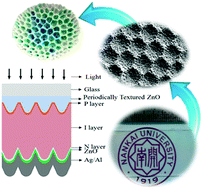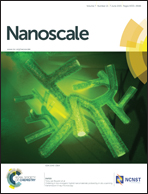Broadband light trapping based on periodically textured ZnO thin films†
Abstract
Transparent conductive front electrodes (TCFEs) deployed in photovoltaic devices have been extensively studied for their significance in transporting carriers, coupling and trapping the incident photons in high-performing solar cells. The trade-off between the light-transmission, electrical, and scattering properties for TCFEs to achieve a broadband improvement in light absorption in solar cells while maintaining a high electrical performance has become the key issue to be tackled. In this paper, we employ self-assembled polystyrene (PS) spheres based on a sauna-like method as a template, followed by a double-layer deposition and then successfully fabricate highly-transparent, well-conductive, and large-scale periodically-textured ZnO TCFEs with broadband light trapping properties. A sheet resistance below 15 Ω sq−1 was achieved for the periodically-textured ZnO TCFEs, with a concomitant average transmission of 81% (including the glass substrate) in the 400–1100 nm spectral range, a haze improvement in a broadband spectral range, and a wider scattering angular domain. The proposed approach affords a promising alternative method to prepare periodically-textured TCFEs, which are essential for many optoelectronic device semiconductors, such as photovoltaic and display applications.


 Please wait while we load your content...
Please wait while we load your content...